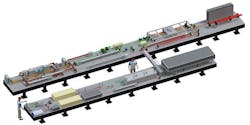LLNL wins $45M to build Extreme Light Infrastructure laser
Livermore, CA--More than $45 million dollars was awarded to Lawrence Livermore National Laboratory (LLNL), through Lawrence Livermore National Security LLC (LLNS), to develop and deliver a laser system for the European Union's Extreme Light Infrastructure Beamlines facility (ELI-Beamlines; http://www.eli-beams.eu/) under construction in Dolni Brezany near Prague in the Czech Republic. Funds have been received and the project will begin immediately.
The agreement will deliver a laser system with performance far more advanced than current laser systems in the world. This will allow the ELI-Beamlines facility to undertake unprecedented research in areas as diverse as medical imaging, particle acceleration, homeland security, and quantum physics, opening up applications in many areas of industry as well as cutting-edge academic research.
LLNL was chosen as the single preferred supplier as a result of its expertise in the research, development and engineering of sophisticated laser systems. This capability is the result of sustained investment in this area by the United States Department of Energy for the Laboratory's national security missions.
"We are proud and excited now to be working with LLNL, which is an internationally recognized center of excellence in high performance lasers," said Jan Ridky, the director of the Institute of Physics of the Academy of Sciences of the Czech Republic. "LLNL was selected by the ELI Beamlines project through a rigorous evaluation process and will develop a world-leading laser system that will be at the heart of the ELI Beamlines user facility. It is evidence that ELI is a European facility, but with a real global dimension. Placement of this contract is a significant milestone as we have now committed over half of the project budget, a tangible demonstration of our progress."
The design goal for the "High repetition-rate Advanced Petawatt Laser System" (HAPLS) calls for peak powers greater than one petawatt (1015 W, 1,000,000,000,000,000 W) at a repetition rate of 10 Hz, with each pulse lasting less than 30 fs. HAPLS combines sophisticated semiconductor diode laser technology with advanced optics, integrated control systems, and techniques for managing the production of ultrashort pulses of light delivered at a repetition rate that is well-suited for the various applications planned for study at the facility.Researchers from LLNL's NIF & Photon Science Directorate will work with scientists from the Czech Institute of Physics to design, develop, assemble and test the system at LLNL. After completion of qualification testing, the HAPLS will be transported to the ELI Beamlines facility in 2016, where it will be commissioned for use by the international scientific community.
"We are honored to have been selected to work with the ELI-Beamlines team on their journey to deliver this step-change in laser capability for the world," said Parney Albright, president of LLNS and director of LLNL. "This marks a new phase in the long-standing relationship between LLNL and the European laser community. It is an exciting time to be in the field of high-power lasers and their many applications to industry, academia and our mutual security."
The ELI-Beamlines facility represents an investment of nearly 7 billion Czech crowns (about $350 million dollars) on behalf of the EU and Czech Republic government. It forms part of the pan-European ELI project that includes construction of two other major new facilities: the ELI-ALPS facility, to be sited in Hungary, to investigate natural phenomena on ultrashort timescales (into the attosecond regime), and the ELI-NP facility, to be sited in Romania, to open up the new field of photonuclear physics.
SOURCE: Lawrence Livermore National Laboratory; https://www.llnl.gov/news/newsreleases/2013/Sep/NR-13-09-06.html

Gail Overton | Senior Editor (2004-2020)
Gail has more than 30 years of engineering, marketing, product management, and editorial experience in the photonics and optical communications industry. Before joining the staff at Laser Focus World in 2004, she held many product management and product marketing roles in the fiber-optics industry, most notably at Hughes (El Segundo, CA), GTE Labs (Waltham, MA), Corning (Corning, NY), Photon Kinetics (Beaverton, OR), and Newport Corporation (Irvine, CA). During her marketing career, Gail published articles in WDM Solutions and Sensors magazine and traveled internationally to conduct product and sales training. Gail received her BS degree in physics, with an emphasis in optics, from San Diego State University in San Diego, CA in May 1986.

